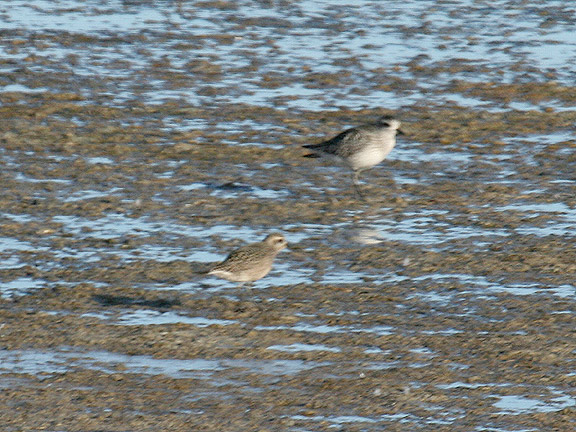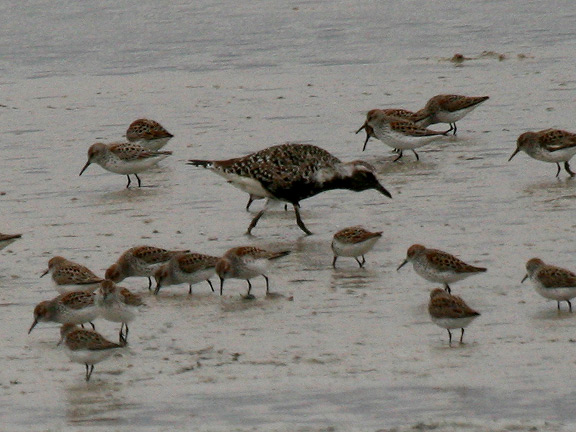The first and most obvious way to judge the size of a bird is by direct comparison to a nearby species that is more common or you recognize. Pretend it’s September and you are driving along the Antelope Island Causeway when you spot a couple of medium shorebirds on the side of the road. Upon closer inspection you recognize the pale, speckled and short-billed one as a Black-bellied Plover. Now you may be saying how did I know they were medium sized? Good question. I think of peeps as being small, and curlews as being large. Basically anything that isn’t as big as a curlew, or as small as a peep falls in the medium range for me, and can help narrow down an ID. Anyways, the other bird is slightly smaller and more streamlined, and has a slight brown-gold wash over its entire body. It looks very similar too the Black-bellied Plover but isn’t quite the same. A quick flip through your field guide to the large plovers and you will find the American Golden-Plover—seeing that it is slightly smaller than its more common cousin. You have just used the size of a bird you recognized to ID a nearby bird.
Using the Black-bellied Plover again let’s try a different scenario. This time it’s the last week of April and you pull up to a huge flock of smaller shorebirds, with one larger bird in the middle. After looking through your binoculars you see the larger bird is a Black-bellied Plover (note the white undertail coverts). That was easy—now what about the hundred or so smaller shorebirds? Using my peeps-to-curlew scale I can safely assume these tiny specks, 1/3 the size of the medium-sized plover are peeps. Given the size, the sheer number, and the long bills my first guess would be that these are Western Sandpipers. Taking a moment to look closely and consulting the book the ID would be confirmed. Having a familiar bird near ones you aren’t sure of can be very helpful. You may not be able to gauge the exact or actual size, but in relation to one another you can definitely help yourself.
Let’s tackle something a little more difficult. Let’s talk about a nondescript bird perched on a post. When you first see it you assume it is small because to the naked eye it is small. After looking through your binoculars you aren’t sure what it is, possibly some type of sparrow. The bird flies off after you look at it for a little bit. What you know is that the bird was slightly smaller than the width of the post it was on. You take a minute to go look at the post which you guess is about 6” wide. That’s not scientific, but it helps a little. If you are really into it you can take a ruler or tape measure with you—but that is a little much. After you figure the size of the post you take into consideration where you are—on Antelope Island in May surrounded by Sage Brush. The small bird was streaked and looked like a sparrow so you flip to that area of your guide and start looking for sparrows in the 5-5 ½” range that lives in or around Sage Brush. Narrowing it down you find the rather drab, rather small, and rather common Sage Brush inhabitant—the Brewer’s Sparrow. It seems to fit. Then you get a little help a couple minutes later when a Sage Thrasher comes in and lands on a similar post. You recognize the thrasher because of its sleek shape, the sharp long bill, streaked plumages and yellow eye. The thrasher is a much larger songbird, about 8 ½” in length helping you be more sure of your measurement of the post—solidifying your thoughts.
After I wrote the first post I received an email from someone who had an owl crash into their window. The Owl then stunned sat on their deck. The person who saw the bird used a very simple and easy method to help them figure out the size of the owl based on the size of the slats on their deck. The slats were 5.5” wide, and the owl was a tiny bit longer than the slats. Based on the small size, along with the fieldmarks they were able to ID the bird as a Northern Pygmy-Owl. Having the size of the slats in the wood as a gauge made it very easy to come up with an estimated size for the owl.
 A stunned but okay Northern Pygmy-Owl
A stunned but okay Northern Pygmy-OwlThe basics are easy: 1) use other birds to judge the size of species in question, 2) use man made or natural objects to help gauge size.
Don’t assume the size of a bird you don’t know because you think it is similar in size to another species that isn’t present for comparison. This will ultimately cause more issues than using the fieldmarks and what is available to measure the bird up. I hope this helps a few people; put it to the test and let me know how it works!
Don’t assume the size of a bird you don’t know because you think it is similar in size to another species that isn’t present for comparison. This will ultimately cause more issues than using the fieldmarks and what is available to measure the bird up. I hope this helps a few people; put it to the test and let me know how it works!
Labels: identification




1 Comments:
Very good pic and info!
Post a Comment
Subscribe to Post Comments [Atom]
<< Back to Previous